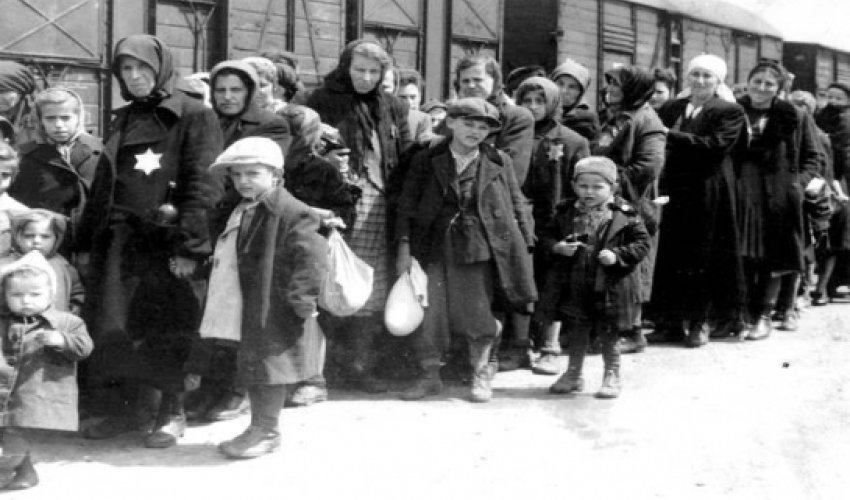How hundreds of Jews used desperate means to jump from Nazi trains

The contents of a latrine bucket helped him jump. It stood in the middle of the floor in a packed and filthy railway cattle wagon bound from Paris to the infamous death camp in Nazi occupied Poland – and it was overflowing.On the night of 5 November 1943, Mr Bretholz, then just 21, and his friend Manfred Silberstein had been trying for hours to prise apart the iron bars of a small window in the side of the wagon. They had been using pullovers as makeshift ropes. Someone suggested soaking them in urine to strengthen their grip on the bars.“I fought to overcome my feelings of nausea,” Mr Bretholz recalled. “I bent down and soaked my pullover in urine. There were bits of excrement floating in it. I felt humiliated. It was the most disgusting thing I had ever done,” he added.Yet the trick paid off. The two young men were able to get the window bars far enough apart to squeeze through. Perched on the outside edge of the cattle wagon they clung on desperately trying to avoid the searchlight guards cast over the rail convoy. When the train went into a corner, they used the concave shadow to jump.The two escaped and managed to survive. Leo Bretholz spent the rest of the Second World War on the run from the Nazis. His death in America just a week ago, aged 93, coincided with new historical research published in Germany which told hitherto unheard stories of the estimated 764 individuals who managed to escape the Holocaust by jumping to freedom from the Nazi trains carrying them to the death camps from France, Holland and Belgium.Tanja von Fransecky, a historian, spent four years conducting interviews and researching archives in Israel and across Europe for her study “Jewish Escapes from Deportation Trains”. She admitted being astounded by the number of people who had managed to escape the Holocaust in this way. “I was amazed that this happened at all,” she told The Independent. “I had always assumed that the wagons were stuffed full prior to departure and simply opened on arrival and that not much could happen in between.”Yet the author found out that the opposite was the case. There were dramatic, agonising and awful scenes as would-be escapers struggled to break free from the Nazi transports with the help of smuggled tools or as in the case of Mr Bretholz, urine-soaked pullovers.Often the escapees faced angry criticism from frightened fellow passengers. “Hadn’t they been told that they would all be shot if someone escaped?” and “who will look after the old, the sick and the tiny children?” they would ask.Dr von Fransecky stressed that the escapees faced a deep moral dilemma, particularly if they left someone behind. “It is one of the reasons why many survivors kept silent for years after the war,” she added.Simon Gronowski, 82, did not talk about his leap to freedom for almost 60 years. As an 11-year-old he was rounded up and held in a Nazi transit camp for Jews near Antwerp, Belgium. His father had managed to escape the Gestapo and he hoped to rejoin him. He had heard about people leaping off the death trains and he used his bunk bed in the Nazi camp to practice jumping.His chance came in March 1943 as he and his mother sat crouched in a stinking cattle wagon bound for Auschwitz. Encouraged by a raid by resistance fighters which managed to free 17 Jews from the train, a group of men in Gronowski’s wagon managed to force open the door. As the train gathered speed, he hesitated but then leapt. His mother’s last words to him were: “The train’s going too fast.” She was murdered in Auschwitz soon afterwards.Simon Gronowski jumped. Others, like 25-year-old Willy Berler did not. Imprisoned aboard an Auschwitz transport traversing Belgium, he was part of a group of six young male prisoners who had managed to break open a cattle wagon window and were escaping one by one.“Anxiously, I watched my comrade as he climbed through the window,” he wrote. “Then I pulled myself up and saw that he hadn’t managed it. It was a horrible sight. The boy was caught between two wagons and his head had been crushed between the buffers like a melon.”Mr Berler said that if he had had the “slightest idea” what awaited him in Auschwitz he would have jumped. Unlike thousands, he survived the camp. Simon Gronowski, who also lost his sister in Auschwitz, only sought to come to terms with his traumatic experiences in 2002.He had a reunion with the armed guard who forced him and his family on to the death camp train in 1943. The guard begged him for forgiveness. The two men wept as they fell into each others’ arms. “My life has been full of miracles,” Mr Gronowski now likes to say.(independent.co.uk)ANN.Az
Latest news 
More news 



































 Photo
Photo 



 Video
Video 

